
 Hymn to the Mothers I am fertile like sun, winds, and watersI flow with rivers, my sacred daughtersI shine when I see my jewel-like cropsI hear the crystals of dews and dropsI walk with pilgrims in search of truthI run with pride and support my youthI am hard like stone and soft like silkI am black like coal and white like milkI breathe in every fragrance of spiceI am reborn with every grain of riceI nurture every new seedling that is bornI cry for every un-lived life and mournI am the sparrow that sings to the farmsI welcome everyone with my open armsI am the gentle Earth that is also airI live in the silent whispers of the prayerI can sacrifice it all, just to hear your voiceI give peace and love, and thats my choice I am India, I am Mother India I welcome the spring with million flowersI bow to the summer and the suns powersI bathe in the warm showers of monsoonI fall with every leaf of the autumn moonI surrender to the harsh winters treasonI will continue to flourish in every season
Hymn to the Mothers I am fertile like sun, winds, and watersI flow with rivers, my sacred daughtersI shine when I see my jewel-like cropsI hear the crystals of dews and dropsI walk with pilgrims in search of truthI run with pride and support my youthI am hard like stone and soft like silkI am black like coal and white like milkI breathe in every fragrance of spiceI am reborn with every grain of riceI nurture every new seedling that is bornI cry for every un-lived life and mournI am the sparrow that sings to the farmsI welcome everyone with my open armsI am the gentle Earth that is also airI live in the silent whispers of the prayerI can sacrifice it all, just to hear your voiceI give peace and love, and thats my choice I am India, I am Mother India I welcome the spring with million flowersI bow to the summer and the suns powersI bathe in the warm showers of monsoonI fall with every leaf of the autumn moonI surrender to the harsh winters treasonI will continue to flourish in every season CONTENTS
CONTENTS 
 Dedicated to all my gurus who taught me how to cook and roll breads and, most important, they were all vegetarian.
Dedicated to all my gurus who taught me how to cook and roll breads and, most important, they were all vegetarian.
They truly showed me the power of food and love. INTRODUCTION  O NE OF MY favorite spaces in the world was our 3-by-10-foot vegetable garden in the backyard of our house in Amritsar, planted and nurtured by my grandmother and me. Aromatic Holy basil, mint, squashes, cilantro, vibrant juicy tomatoes, tangy lemons...I took real pride in my hand-grown herbs and vegetables that I so lovingly tended to each morning and every afternoon when I came back from school. The thrill of rushing home, sometimes with a stolen seedling root pulled out secretly from a neighbors unattended garden to be replanted in my tiny gardenmy own, my very own corner of paradise, which I called the Temple of Pearls.
O NE OF MY favorite spaces in the world was our 3-by-10-foot vegetable garden in the backyard of our house in Amritsar, planted and nurtured by my grandmother and me. Aromatic Holy basil, mint, squashes, cilantro, vibrant juicy tomatoes, tangy lemons...I took real pride in my hand-grown herbs and vegetables that I so lovingly tended to each morning and every afternoon when I came back from school. The thrill of rushing home, sometimes with a stolen seedling root pulled out secretly from a neighbors unattended garden to be replanted in my tiny gardenmy own, my very own corner of paradise, which I called the Temple of Pearls.  I would sit there and see the most beautiful transformations happening every moment. When I would shell a pea, it contained green gems; when I would cut an okra, white rubies would fall on my palm.
I would sit there and see the most beautiful transformations happening every moment. When I would shell a pea, it contained green gems; when I would cut an okra, white rubies would fall on my palm.
Sometimes when I saw a squash that had grown high on the rooftop and we had not noticed it was drying, beautiful pearls of life for the next season would be contained within. During winter, wherever I saw mustard growing, I would immediately support it by tying it with a thread to the stick I dug into the ground next to it. The mustard flowers would shine with the reflection of the winter sun. I even grew fenugreek once, and after four months or so it had diamond-shaped yellow seeds sprouting slowly. Nature has its own way of expressing its glory. The whole process of waiting and watching the seedling slowly break out through the soil, and then the eagerness to finally see its little flowers and fruits, was a delight in itself.
One summer morning, years ago, I was woken up by my sister Radhika whose face was glowing. Its here! she said with a twinkle in her eyes. In a flash, I was out of bed and both of us ran out to the garden. Panting, we stopped right in front of the tomato plant and there it wasa small, tiny, perfectly round green tomato. For us, it was the best day of the year and the smiles didnt leave our faces all day. Crowning moments were when freshly plucked mint or perfect ripe tomatoes from my garden made their way to our family table.
My chest would overflow with emotion as I oversaw the dinner service with my Biji...handing out second helpings, proudly reminding everyone that the potato curry tasted extra special that night as the cilantro garnish was from my vegetable garden. At the same time, though, when I sat down to eat, the spoon never seemed to reach my mouth. Just the thought that I was about to consume something I had so lovingly grown and nurtured with my own hands made me sad. Thus, the best days of the year were always followed by the worst days; and then the plants would bear fruit and the world would be a happy place again. Every Sunday, I would make my way to the markets shopping for home or for my BanquetsLawrence Gardens, where the farmers of Punjab would gather, bringing with them an abundance of freshly harvested fruits and vegetables. Those were the days when we would still cook and eat as per the season.
Today, in a seasonless world of vegetables and fruits, I sometimes miss the anticipation of choices gifted by the seasons. There is a certain pleasure in eating the vegetables in seasonthe glistening, firm, and juicy produce gives an extra boost of flavor and color to the recipes we cook. I suppose it was my small vegetable patch while growing up that gently established my deep connection with Mother Earthit asks so little of us and in return showers us with its gifts and promises. It inspired me to cook wonderful feasts, to bring natural and combined flavors together with elegant ingredients, give them center stage and design a recipe. As I mix and match the familiar with the unfamiliar, at times I conjure up new taste combinations, a flavorful twist. Other times I simply rely on the tried and tested recipes and techniques handed down over generations.
In present times, all fruits and vegetables are available all year round in many parts of the world, thanks to the technological advances in cultivation and preserving techniques. There is only a handful of produce that can really be called seasonal. This does lead to a greater choice in ingredients at any given time. Vegetarianism has always been an integral part of the Indian culture, and nowadays is becoming the preferred choice of health-conscious diners. People everywhere are looking to incorporate more vegetables in their meals. In addition to the repertoire of traditional classic vegetarian recipes, there will always remain a need for a taste of something new, something different.
While I was growing up, vegetables were the center point of dining and buying vegetables was a big social event. The vegetables vendora small, thin fellow with a booming voice that didnt match his appearancewould come calling out to the Aunty ji to come sample his latest produce. Aunty ji aaj ki taazi gobi lo, sasti bhi haiGaajar shakkar se bhi meethi haiMattar ek baar khao, to rooz khaogeJaati bahaar ki shalgam hai, le lo achaar bana lenaAunty ji, jitni sasti subzi main deta hoon, koi nahi de sakta.Saari Subzi khet se chunke lata hoon. Aunty ji, do buy this cauliflower! Its fresh and whats more, its cheap too! The carrots are sweeter than sugar! And the green peasyou eat them once, youll eat them every day! Its your last chance to buy these turnips, so do make a good pickle out of them. Aunty ji, this reasonable price at which I sell my vegetables, nobody else does! I personally pick and choose them from the farms!!! So, having sent their husbands and children off to their offices and schools respectively, all the women of the locality would gather around the vegetable vendor. The ladies, with their hair still wet and the fragrance of rose shampoo around them, would swoop down on the laden cart, while the clever vendor would keep them entertained with his constant chatter. As their expert hands deftly picked the best vegetables (all the time making sure the others didnt lay their hands on those tender beans or those crisp firm cucumbers), they would exchange notes and gossip.
Next page















 Hymn to the Mothers I am fertile like sun, winds, and watersI flow with rivers, my sacred daughtersI shine when I see my jewel-like cropsI hear the crystals of dews and dropsI walk with pilgrims in search of truthI run with pride and support my youthI am hard like stone and soft like silkI am black like coal and white like milkI breathe in every fragrance of spiceI am reborn with every grain of riceI nurture every new seedling that is bornI cry for every un-lived life and mournI am the sparrow that sings to the farmsI welcome everyone with my open armsI am the gentle Earth that is also airI live in the silent whispers of the prayerI can sacrifice it all, just to hear your voiceI give peace and love, and thats my choice I am India, I am Mother India I welcome the spring with million flowersI bow to the summer and the suns powersI bathe in the warm showers of monsoonI fall with every leaf of the autumn moonI surrender to the harsh winters treasonI will continue to flourish in every season
Hymn to the Mothers I am fertile like sun, winds, and watersI flow with rivers, my sacred daughtersI shine when I see my jewel-like cropsI hear the crystals of dews and dropsI walk with pilgrims in search of truthI run with pride and support my youthI am hard like stone and soft like silkI am black like coal and white like milkI breathe in every fragrance of spiceI am reborn with every grain of riceI nurture every new seedling that is bornI cry for every un-lived life and mournI am the sparrow that sings to the farmsI welcome everyone with my open armsI am the gentle Earth that is also airI live in the silent whispers of the prayerI can sacrifice it all, just to hear your voiceI give peace and love, and thats my choice I am India, I am Mother India I welcome the spring with million flowersI bow to the summer and the suns powersI bathe in the warm showers of monsoonI fall with every leaf of the autumn moonI surrender to the harsh winters treasonI will continue to flourish in every season CONTENTS
CONTENTS 
 Dedicated to all my gurus who taught me how to cook and roll breads and, most important, they were all vegetarian.
Dedicated to all my gurus who taught me how to cook and roll breads and, most important, they were all vegetarian. O NE OF MY favorite spaces in the world was our 3-by-10-foot vegetable garden in the backyard of our house in Amritsar, planted and nurtured by my grandmother and me. Aromatic Holy basil, mint, squashes, cilantro, vibrant juicy tomatoes, tangy lemons...I took real pride in my hand-grown herbs and vegetables that I so lovingly tended to each morning and every afternoon when I came back from school. The thrill of rushing home, sometimes with a stolen seedling root pulled out secretly from a neighbors unattended garden to be replanted in my tiny gardenmy own, my very own corner of paradise, which I called the Temple of Pearls.
O NE OF MY favorite spaces in the world was our 3-by-10-foot vegetable garden in the backyard of our house in Amritsar, planted and nurtured by my grandmother and me. Aromatic Holy basil, mint, squashes, cilantro, vibrant juicy tomatoes, tangy lemons...I took real pride in my hand-grown herbs and vegetables that I so lovingly tended to each morning and every afternoon when I came back from school. The thrill of rushing home, sometimes with a stolen seedling root pulled out secretly from a neighbors unattended garden to be replanted in my tiny gardenmy own, my very own corner of paradise, which I called the Temple of Pearls.  I would sit there and see the most beautiful transformations happening every moment. When I would shell a pea, it contained green gems; when I would cut an okra, white rubies would fall on my palm.
I would sit there and see the most beautiful transformations happening every moment. When I would shell a pea, it contained green gems; when I would cut an okra, white rubies would fall on my palm.